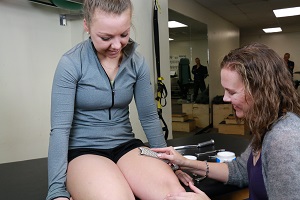Common diagnosis treated with IASTM include plantar fasicitis, tendinitis, carpal tunnel, and IT Band syndrome. IASTM is said to be the modern evolution from Traditional Chinese Medicine called Gua Sha, however Gua Sha was not used to treat muscle, tendon or soft tissue conditions, as it was traditionally used to remove bad energy through the skin.3 The IASTM used today was derived from the Cyriax cross-friction massage developed by Dr. James Cyriax, better known as the father of orthopedic medicine. He was a British orthopedic surgeon whose work has had great influence in the fields of sports medicine and physical therapy.1
There are many different versions of IASTM out there these days. Tools are typically made of stainless steel or hard plastic and designed to contour the shape of the body. Graston Technique®, Astym® and HawkGrips® are a few of the tools making up much of the news these days.
How does it work?
The therapist applies firm pressure to the tool as the tool glides across the tissue in a scrapping fashion. A lubricant of some sort, typically lotion, is used to allow the tools to glide across the skin more freely.

The instruments work to comb through soft tissue restrictions and scar tissue, producing microtrauma to the affected tissue. This stimulates a local inflammatory process, initiating reabsorption of unhealthy tissue and promoting tissue remodeling and healthy tissue production.1 Soft tissue restrictions can occur following surgery. These restrictions can also develop from overuse, such as running, throwing, repeated motions at work, or even prolonged postures sitting at a desk. Likewise, they can develop with lack of use, as may be the case with prolonged splinting or bracing.
What does the research show?
The first controlled research study looking at IASTM was published in 1997.1 Since that time there has been an abundance of work published supporting the use of IASTM for treatment of various conditions.
Research supports the idea that IASTM may have an impact on physiological changes by providing an increase in blood flow, reduction in tissue viscosity, myofascial release, interruption of pain receptors, and improvement of flexibility of underlying tissue. It is suggested that IASTM is an effective treatment intervention for reducing pain and improving function in less than a three-month period.5
In one study, participants with chronic plantar fascitis significantly improved in three of the five variables measured over a six week treatment of Graston Technique®, as compared to those that received massage and those that did not receive treatment at all. The study showed that IASTM with Graston Technique® and plantar fascia-specific stretching was effective in decreasing pain and improving foot function in patients with chronic plantar fascitis. Participants were tested before and after treatment to determine effect on foot pain, function and health. Improvements were noted in all three categories for those participants receiving Graston Technique®.2
Another study found that IASTM to the back of the shoulder can help to increase passive shoulder range of motion in collegiate baseball players.4 Research has also shown benefits include improving range of motion in uninjured individuals as well as pain and patient reported function in both injured and uninjured patients.1
What conditions would benefit from IASTM?
- Tendinitis/Tendinosis (Achilles, epicondylitis, patellar rotator cuff)
- Plantar Fasciitis
- Carpal Tunnel Syndrome
- Trigger Finger
- Neck and back pain
- Sprains and Strains
- ITB Syndrome
- Myofascial Restrictions
- Post-surgical scaring
- Post-mastectomy scarring
- Caesarean scarring
At Athletico, we have therapists that are trained to safely and effectively treat the aforementioned conditions with IASTM, either with Graston Technique®, Astym® or HawkGrips® tools. IASTM is just one of the many manual therapy tools in a physical therapist’s tool box that can be used to treat pain. If you think you would benefit from IASTM, request a free assessment at your nearby Athletico.
Physical therapy is usually the thing you are told to do after medication, x-rays or surgery. The best way to fix your pain is to start where you normally finish – with physical therapy at Athletico. Schedule a free assessment in-clinic or virtually through a secure online video chat where our team can assess your pain and provide recommended treatment options.
The Athletico blog is an educational resource written by Athletico employees. Athletico bloggers are licensed professionals who abide by the code of ethics outlined by their respective professional associations. The content published in blog posts represents the opinion of the individual author based on their expertise and experience. The content provided in this blog is for informational purposes only, does not constitute medical advice and should not be relied on for making personal health decisions.
References:
1. Cristina B. Seffrin, MS, LAT, ATC, et al. “Instrument-Assisted Soft Tissue Mobilization: A Systematic Review and Effect-Size Analysis.” Journal of Athletic Training (2019).
2. Garrett TR, Neibert PJ. “Effect of Graston Technique as a Treatment for Patients with Chronic Plantar Fasciosis: A Rendomized Controlled Trial.” Journal of Athletic Training 9.3 (2014): 57-58.
3. Instrument Assisted Soft Tissue Mobilization. n.d. 22 December 2019. <https://www.physio-pedia.com/Instrument_Assisted_Soft_Tissue_Mobilization>.
4. Kevin Laudner, PhD, ATC, et al. “ACUTE EFFECTS OF INSTRUMENT ASSISTED SOFT TISSUE MOBILIZATION FOR IMPROVING POSTERIOR SHOULDER RANGE OF MOTION IN COLLEGIATE BASEBALL PLAYERS.” International Journal of Sports Physical Therapy (2014): 1-7.
5. Lamber, Matthew, et al. “The effects of instrument-assisted soft tissue mobilization compared to other interventions on pain and function: a systematic review.” Physical Therapy Reviews 22.1-2 (2017).

 width="900"
height="356"
>
width="900"
height="356"
>
